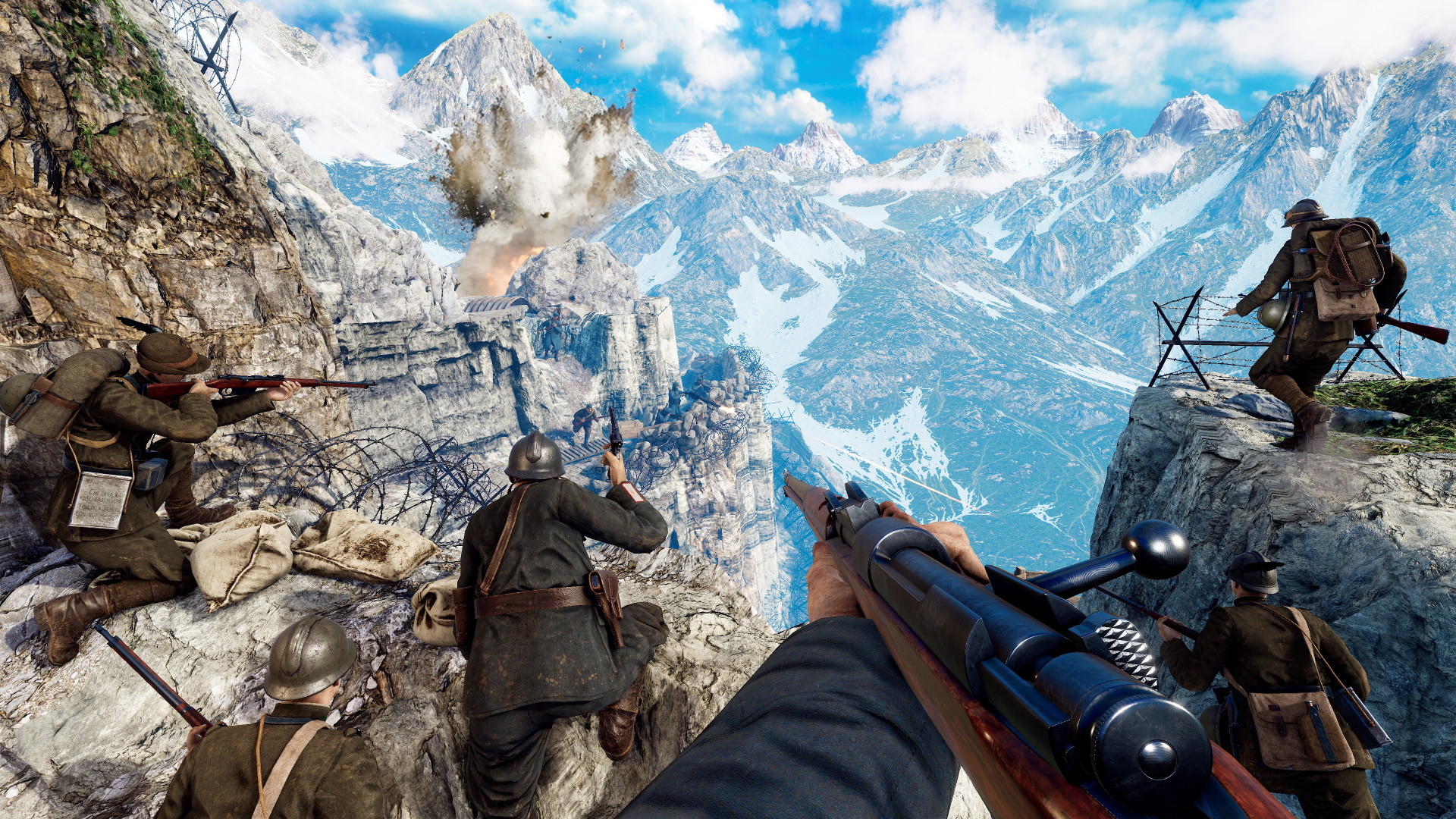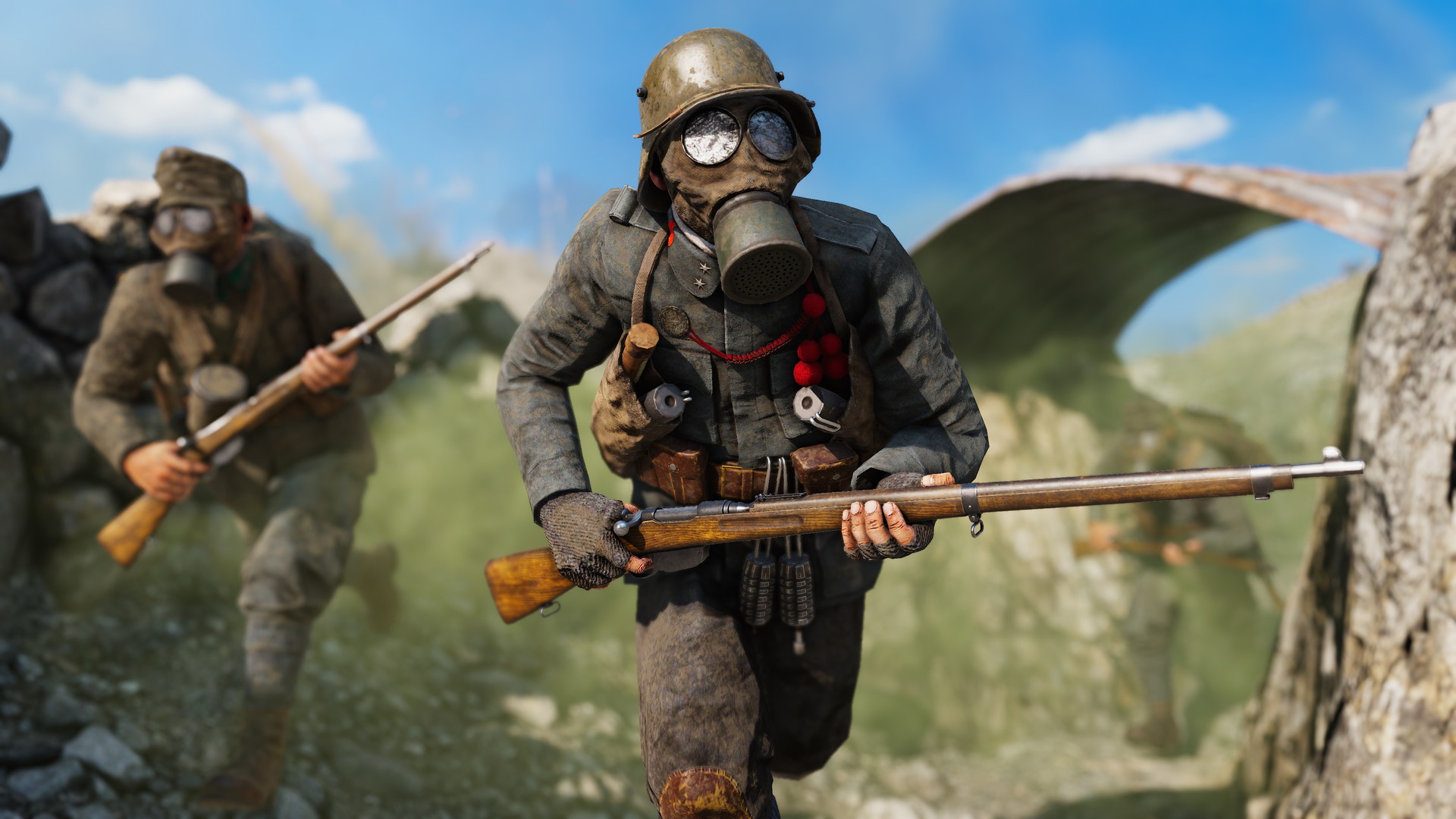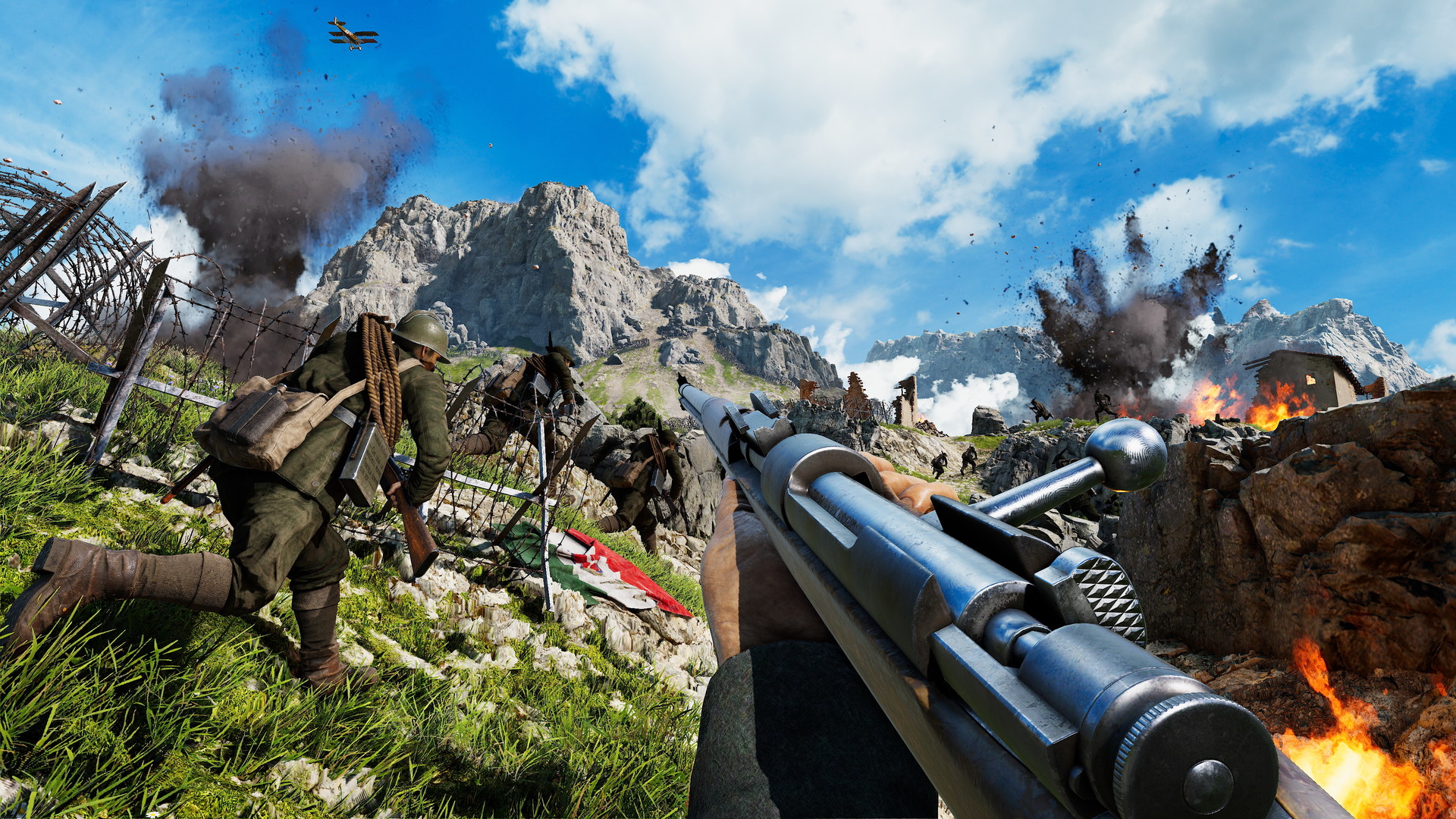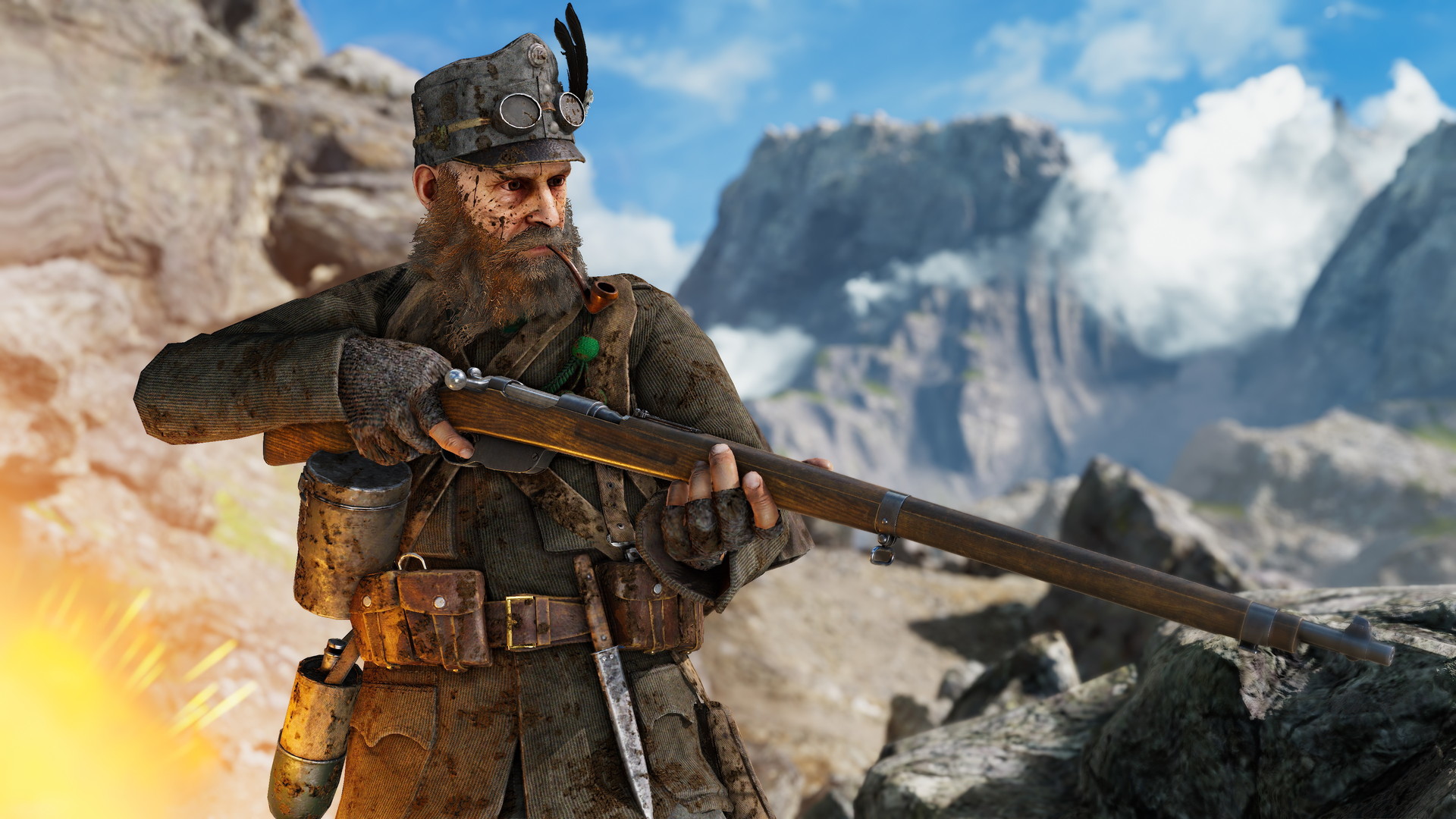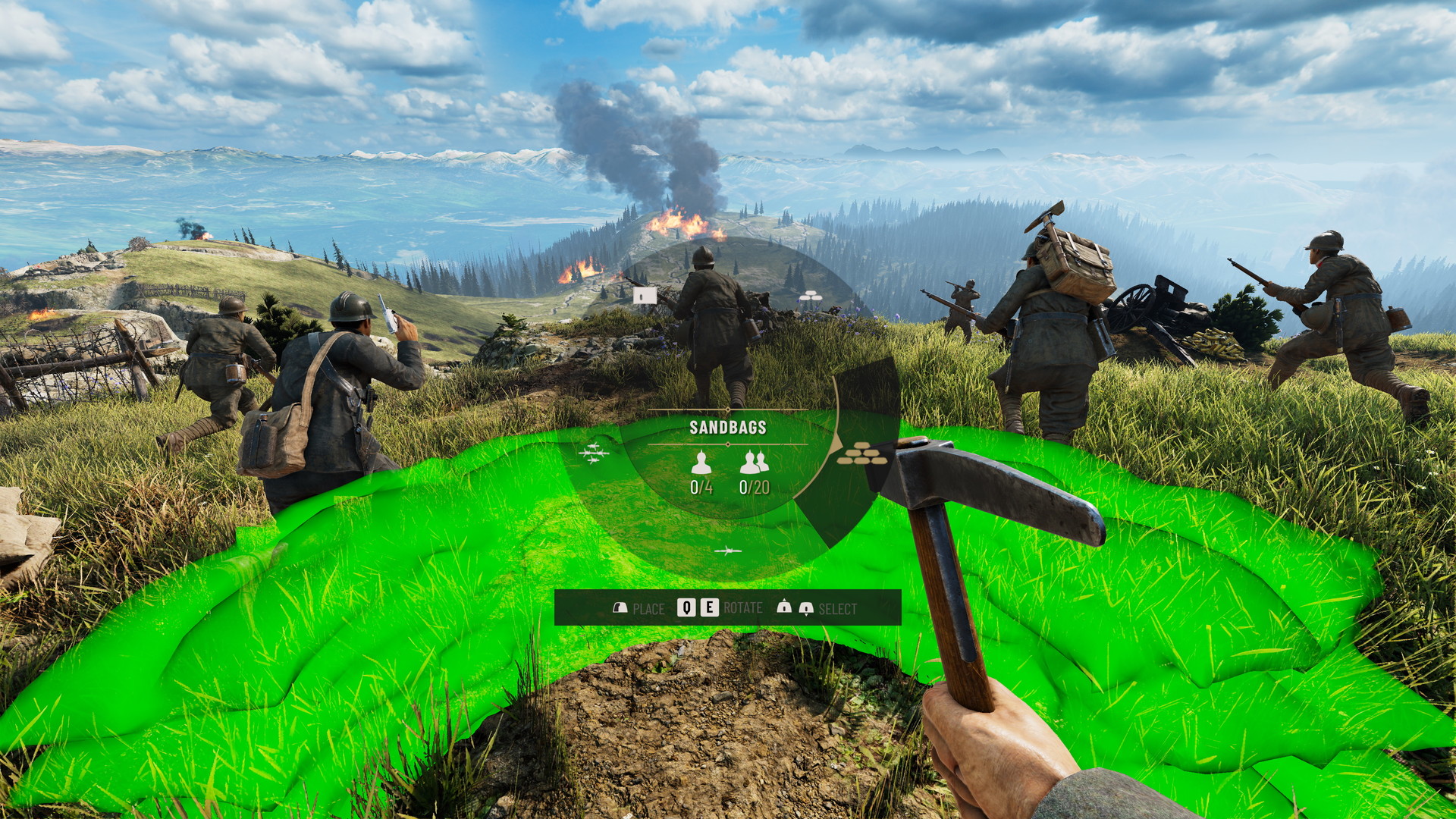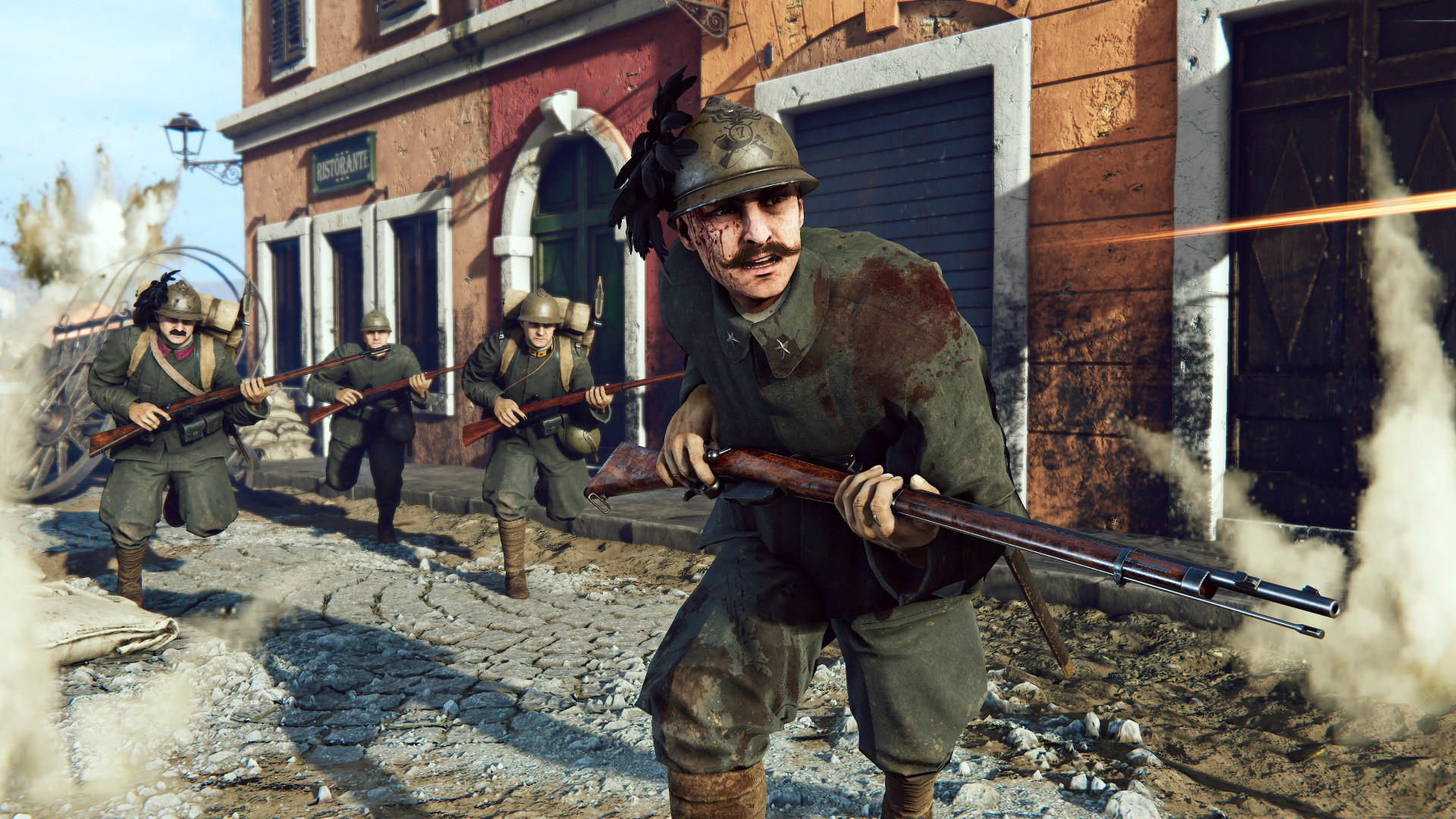World War One expands to the mountains of the Italian Front - beautiful but deadly in equal measure. Inspired by the two year struggle for control of the Isonzo river valley and the Alps during World War One, Isonzo elevates the WW1 Games Series, figuratively and literally.
From the makers of Verdun and Tannenberg …
The new Offensive game mode puts you right in the middle of key historical offensives on the Italian Front. Lead the charge across stunning Italian landscapes as you choose your path to victory - cut paths through barbed wire, flank your enemies by following mountain trails, or man a mortar to blast a way through. Shape a dynamic battlefield by laying sandbags and wire, placing ammo crates, deploying trench periscopes or sniper shields, and more.

Take part in historical offensives from the Sixth Battle of the Isonzo to the Strafexpedition. Reflecting the course of the actual battles, as the attackers advance the fighting will shift through vastly different landscapes within a single offensive: from hillside fortresses to mountain trenches and fierce urban combat on city streets. Everything is recreated based on research and field trips, from sound effects and uniforms down to the houses, vineyards and trenches you’ll be fighting over.
Call in support with a unique historically accurate flare system: flare guns can mark targets for artillery or biplane flybys, or different colored flares can be used to guide your team. Once the big guns have softened up the enemy, finish the job at close quarters with an Arditi dagger or mountaineer’s pickaxe. Man heavy machine guns, mortars and even mountain guns for more direct fire support.

Choose from six classes based on historical combat roles and build your loadout from a selection of weapons, equipment and perks linked to that class, giving flexibility and variety while staying grounded in what real soldiers might have carried. You’ll be operating wire cutters, bandaging yourself and wounded teammates, and blowing the whistle to start an assault. One shot can kill and even lighter injuries can lead to quickly bleeding out.
Being an effective soldier in Isonzo is not just about being a good marksman. Mastering the terrain is also key - the mountain can be a friend or foe. Learn how to navigate well to maintain cover and surprise your enemies or support your allies.
Finally… watch out for the dreaded poison gas. You’ve never experienced WW1 action quite like this!
Isonzo key features include:
More Games in the Authentic WW1 Game Series
Immerse yourself in more WW1 action with our other standalone titles Tannenberg and Verdun. Experience trench warfare on the Western Front in Verdun, or maneuver for control of key sectors in Tannenberg on the Eastern Front. These authentic WW1 shooters let players choose from a range of squads from across the war, as they fight for control of the ever-changing frontlines.
From the makers of Verdun and Tannenberg …
The new Offensive game mode puts you right in the middle of key historical offensives on the Italian Front. Lead the charge across stunning Italian landscapes as you choose your path to victory - cut paths through barbed wire, flank your enemies by following mountain trails, or man a mortar to blast a way through. Shape a dynamic battlefield by laying sandbags and wire, placing ammo crates, deploying trench periscopes or sniper shields, and more.

Take part in historical offensives from the Sixth Battle of the Isonzo to the Strafexpedition. Reflecting the course of the actual battles, as the attackers advance the fighting will shift through vastly different landscapes within a single offensive: from hillside fortresses to mountain trenches and fierce urban combat on city streets. Everything is recreated based on research and field trips, from sound effects and uniforms down to the houses, vineyards and trenches you’ll be fighting over.

Call in support with a unique historically accurate flare system: flare guns can mark targets for artillery or biplane flybys, or different colored flares can be used to guide your team. Once the big guns have softened up the enemy, finish the job at close quarters with an Arditi dagger or mountaineer’s pickaxe. Man heavy machine guns, mortars and even mountain guns for more direct fire support.

Choose from six classes based on historical combat roles and build your loadout from a selection of weapons, equipment and perks linked to that class, giving flexibility and variety while staying grounded in what real soldiers might have carried. You’ll be operating wire cutters, bandaging yourself and wounded teammates, and blowing the whistle to start an assault. One shot can kill and even lighter injuries can lead to quickly bleeding out.
Being an effective soldier in Isonzo is not just about being a good marksman. Mastering the terrain is also key - the mountain can be a friend or foe. Learn how to navigate well to maintain cover and surprise your enemies or support your allies.
Finally… watch out for the dreaded poison gas. You’ve never experienced WW1 action quite like this!
Isonzo key features include:
- Mountain warfare: Assaulting mountain fortifications, battling through ruined towns, and fording rivers are just a few of the challenges you’ll face as you fight your way through numerous enemy positions
- Tactical multiplayer FPS: Choose your role and loadout carefully to survive this high altitude combat - play a sniper to pick off the enemy engineers before they can cut your wire, use rifle grenades to clear enemy machine guns, and much more
- World War One Gameplay: Historical Offensive game mode based on real battles and focused on the unique challenges of Alpine warfare. Fight with 30+ WW1 weapons, poisonous gas attacks, and intense artillery barrages
- Build for victory: Place your own wire, sandbags, trench periscopes, and more! Whether you’re digging in or on the attack, shaping the battlefield to your advantage will be key to victory
- Faces of war: Make every class your own by picking from a variety of historically class-appropriate uniforms, accessories and headgear. As a finishing touch, you can even pick your mustache from several famous period-accurate styles!
- Authentic WW1 atmosphere: Accuracy in everything from maps and weaponry to music and the uniforms – fight for the Kingdom of Italy or the Austro-Hungarian Dual Monarchy

More Games in the Authentic WW1 Game Series
Immerse yourself in more WW1 action with our other standalone titles Tannenberg and Verdun. Experience trench warfare on the Western Front in Verdun, or maneuver for control of key sectors in Tannenberg on the Eastern Front. These authentic WW1 shooters let players choose from a range of squads from across the war, as they fight for control of the ever-changing frontlines.
Dev Blog #19 - Meet the engineer (not that one)
 Italian engineers constructing wire on Monte Sabotino.
Italian engineers constructing wire on Monte Sabotino.
Military engineers have been a feature of armies for a long, long time. Since early siege engines required specialists to build and operate them, engineers have accompanied armies. Also responsible for field defenses, engineers were vital throughout the First World War for all sides. On the Italian Front, the mountainous terrain would pose a constant challenge to both sides as they struggled to build defenses, supply their troops, and launch attacks in the rugged terrain. Engineers were responsible for more permanent fortifications, logistics systems like cranes or cable cars, and their work was important for offensive actions too.

Part of the Austro-Hungarian tunnel complex carved out from the Marmolada Glacier in 1916.
In the Dolomite region, there were more than 30 mines detonated between 1916 and 1918, with explosions large enough to change the landscape: peaks lowered, cliffs shifted. The tunnels for these mines would be dug by engineers. We also saw back in Isonzo Intel #12 how Italian engineers prepared mountainside walkways to get the jump on defenders!
 Austro-Hungarian engineers.
Austro-Hungarian engineers.
Second, they can very effectively build and cut wire - often there will be nearly impenetrable lines of wire facing attackers when the battle begins, only needing defending engineers to close up a few gaps. These chokepoints will be high priority areas for both sides. Attacking engineers can more quickly cut wire, or potentially even blow it up to prevent the defenders repairing it.
But engineers are not limited to these pre-set points of interest when building

An engineer built sandbag position.
Sandbags
There are two forms of sandbag available, one straight piece of sandbag wall, and one curved sandbag position. The curved sandbags are ideal for standalone defensive positions where you want to provide a little cover against flanking enemies. The straight sandbag walls work better when combined into a larger position, or as an extension to map features like buildings, stone walls, and ruins. In some places you might be able to use sandbags to hinder enemies trying to climb onto ledges.

Construction UI.
Barbed Wire
Barbed wire works exactly as youd expect, slowing and hurting soldiers who get caught up in it. There are two types available, but well go into more detail in a future dev blog.
Sniper Shields
These specialist items are small metal shields with a firing slot in them. When carefully positioned they will protect a soldier from enemy fire while allowing them to shoot back. However, finding a good spot with a decent field of view through the tiny slot is not easy!

An engineer constructs a sniper shield.
 Armored engineers in action.
Armored engineers in action.
Engineer
The Engineer supports the team by handling engineering tasks such as constructing static weaponry, cutting wire efficiently and deploying extra defenses and obstacles around the battlefield. Italian engineers constructing wire on Monte Sabotino.
Italian engineers constructing wire on Monte Sabotino.Military engineers have been a feature of armies for a long, long time. Since early siege engines required specialists to build and operate them, engineers have accompanied armies. Also responsible for field defenses, engineers were vital throughout the First World War for all sides. On the Italian Front, the mountainous terrain would pose a constant challenge to both sides as they struggled to build defenses, supply their troops, and launch attacks in the rugged terrain. Engineers were responsible for more permanent fortifications, logistics systems like cranes or cable cars, and their work was important for offensive actions too.

Part of the Austro-Hungarian tunnel complex carved out from the Marmolada Glacier in 1916.
In the Dolomite region, there were more than 30 mines detonated between 1916 and 1918, with explosions large enough to change the landscape: peaks lowered, cliffs shifted. The tunnels for these mines would be dug by engineers. We also saw back in Isonzo Intel #12 how Italian engineers prepared mountainside walkways to get the jump on defenders!
 Austro-Hungarian engineers.
Austro-Hungarian engineers.Equipment and Skills
Engineers can choose from a few different rifles, sidearms, and grenades if they wish, but combat isnt their primary task. Instead they should be focused on supporting their team in a few different ways. First off, engineers can build heavy weapons in pre-set locations on each map. This includes heavy machine guns and mortars - the firepower of these weapons can be game changing.Second, they can very effectively build and cut wire - often there will be nearly impenetrable lines of wire facing attackers when the battle begins, only needing defending engineers to close up a few gaps. These chokepoints will be high priority areas for both sides. Attacking engineers can more quickly cut wire, or potentially even blow it up to prevent the defenders repairing it.
But engineers are not limited to these pre-set points of interest when building
Construction System
In Isonzo, certain classes are able to build fortifications which can be freely placed anywhere with enough clear space. The Engineer has the widest variety of things to build, all focused on providing cover to allies or providing obstacles to enemy movement. All buildable items in Isonzo have a maximum amount which can be built at once - there is a per team limit, and a per player limit. So as an Engineer your team might be able to build 20 sandbag positions, and you personally can place 5 of them. It takes a short time to put things together, and you can deconstruct them as well (including enemy items). Lets look at what kind of things you can build
An engineer built sandbag position.
Sandbags
There are two forms of sandbag available, one straight piece of sandbag wall, and one curved sandbag position. The curved sandbags are ideal for standalone defensive positions where you want to provide a little cover against flanking enemies. The straight sandbag walls work better when combined into a larger position, or as an extension to map features like buildings, stone walls, and ruins. In some places you might be able to use sandbags to hinder enemies trying to climb onto ledges.

Construction UI.
Barbed Wire
Barbed wire works exactly as youd expect, slowing and hurting soldiers who get caught up in it. There are two types available, but well go into more detail in a future dev blog.
Sniper Shields
These specialist items are small metal shields with a firing slot in them. When carefully positioned they will protect a soldier from enemy fire while allowing them to shoot back. However, finding a good spot with a decent field of view through the tiny slot is not easy!

An engineer constructs a sniper shield.
Perks
Engineer perks tend towards construction and demolition. The Sapper Company perk gives a bonus to planting and defusing sabotage bombs, making it equally useful when attacking or defending. Support Company gives a bonus to operating heavy weapons: for instance faster reloading and aiming. This has natural synergy with the Engineers job of constructing those heavy weapons, allowing them to then provide better fire support to their team. The Death Company perk gives players body armor they can equip during battle. As with the marksman armor, it protects from explosions and suppression - useful when trying to build or sabotage under fire! Armored engineers in action.
Armored engineers in action.We hope you enjoyed meeting the engineer
See you next time and dont forget to wishlist Isonzo![ 2022-05-19 22:43:39 CET ] [Original Post]
Minimum Setup
- OS: Requires a 64-bit processor and operating system
- Processor: Intel Core 2 Quad Q9550Memory: 4 GB RAM
- Memory: 4 GB RAM
- Graphics: NVIDIA GeForce GT 640
- Storage: 20 GB available space
Recommended Setup
- OS: Requires a 64-bit processor and operating system
- Processor: Intel i7-4770Memory: 16 GB RAM
- Graphics: NVIDIA GeForce GTX 1050
- Storage: 20 GB available space
GAMEBILLET
[ 6425 ]
GAMERSGATE
[ 3784 ]
MacGamestore
[ 2906 ]
FANATICAL BUNDLES
HUMBLE BUNDLES
by buying games/dlcs from affiliate links you are supporting tuxDB

